Hornbills are a family of birds found in subtropical Africa, Asia and Melanesia (Papua Guinea, Fiji, Solomon Islands, and Vanuatu).
Of the 24 species of hornbills in Africa, six of them are found in South Africa. And all of these hornbills of South Africa are found in Kruger National Park.
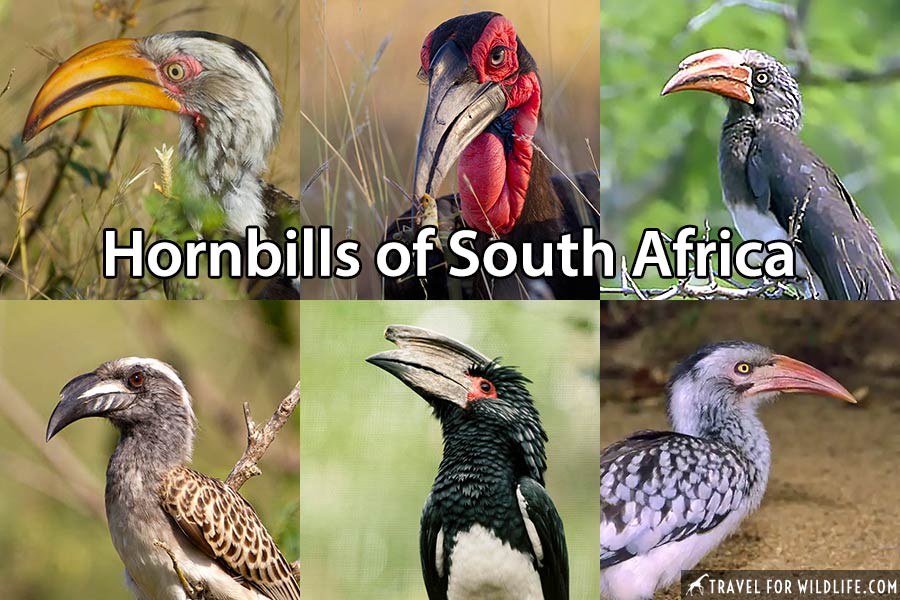
These arboreal or semi-terrestrial birds vary in size (the Southern ground hornbill is the largest hornbill species in South Africa) and have an omnivorous diet.
Their large bills are very distinct and heavy, and are supported by powerful neck muscles. This large bill is used in preening, foraging, nest construction, and fighting. Even though their bills look pretty solid, they are light and honey-combed with air pockets. Some hornbills are equipped with a horn-like casque (larger in males) that sticks out of the top of their bill .

Hornbills are monogamous and they nest in tree trunks and rock cavities. When nesting, the female seals herself up inside the nesting cavity by blocking the entrance with mud, droppings, and regurgitated food. She leaves a narrow slot that they male uses to feed the adult female through. This creates a nearly predator-proof nest. She will stay sealed inside the cavity for about 2.5 months. This behavior ensures that the chicks are fully protected against predation.
The hornbill is an omnivorous bird and feeds on invertebrates, small mammals, small lizards, birds eggs, birds nestlings, seeds, and fruits. They seem to be very fond of figs.
*This article may contain affiliate links. We receive a small commission at no extra cost to you.*
Bird guides of South Africa
- Birds of Southern Africa, Princeton Field Guides by Ian Sinclair, Phil Hockey, et al.
- Roberts Birds of Southern Africa, by Hugh Chittenden, Greg Davies, and Ingrid Werersbye
- Birds of Southern Africa: the complete photographic guide, by Ian Sinclair
Crowned Hornbill (Lophoceros alboterminatus)
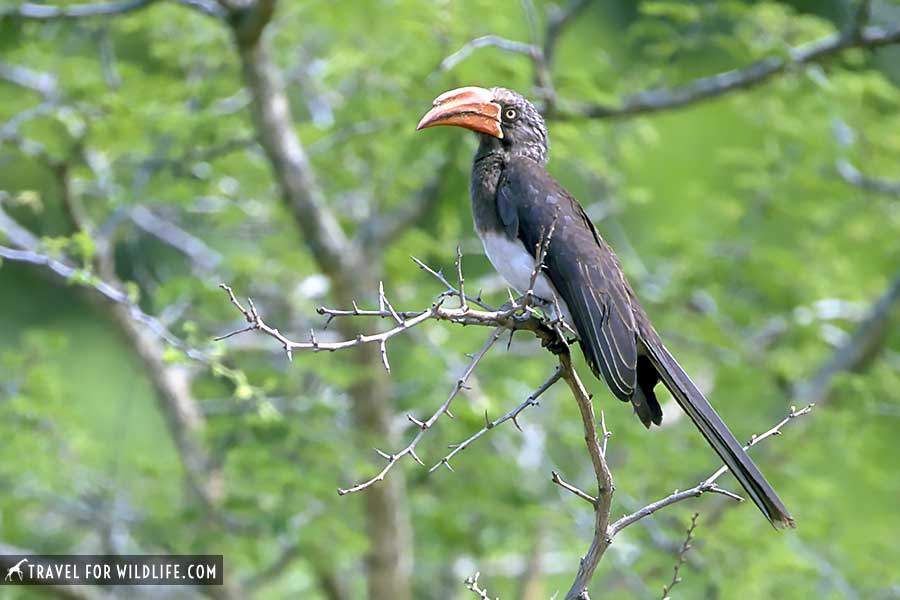
Length: 19.5 – 21 inches Weight: 8 ounces
Conservation status: Least concern (IUCN Red List 2016)
Found in woodlands, the crowned hornbill (Lophoceros alboterminatus) has dark brown plumage, yellow eyes, white belly, and is the only hornbill in South Africa that has a yellow strip at the base of its bill. You can find crowned hornbills foraging in groups around the forest canopy. They can pick insects off vegetation and can also catch flying insects in the air.
Their diet consists of invertebrates and small animals, and in the winter they’ll supplement their diet with fruits.
Southern Ground hornbill (Bucorvus leadbeateri)
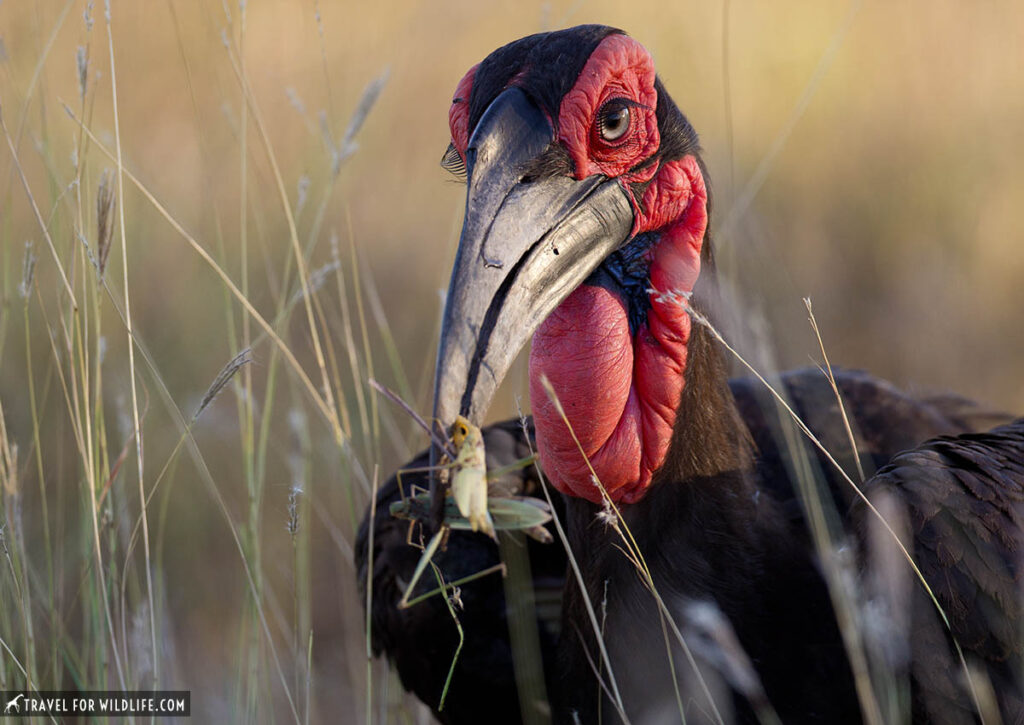
Length: 43 inches, Weight: 8.3 pounds
Life expectancy: 70 years
Conservation status: Vulnerable (IUCN Red List 2016)
The largest of the South African hornbills, the Southern ground hornbill (Bucorvus leadbeateri) is an endangered bird and any encounter with these incredible animals is memorable. They can measure over three feet tall, weight up to 14 pounds, and have a wingspan of about five feet. Their large size and their red facial skin makes them easy to identify in the field.
You can see these large birds walking around the savanna in small family groups, occasionally up to 12 individuals. We saw the individual in the photo with another adult and a juvenile (juvenile southern ground hornbills have yellow face markings instead of red). We observed them for a while as they were foraging for insects. Once they had found one, they would carry it around (as in the photo), showing their find to the other family members as if they were very proud of it.
Southern ground hornbills have a long lifespan and can live up to 70 years of age in the wild. Young birds don’t reach maturity until they are about 10 years old.
To learn more about the conservation efforts to save the Southern Ground hornbill visit Mabula Ground-Hornbill Project. You can submit your southern ground hornbill sightings directly on their website or by emailing them at esearch@ground-hornbill.org.za.
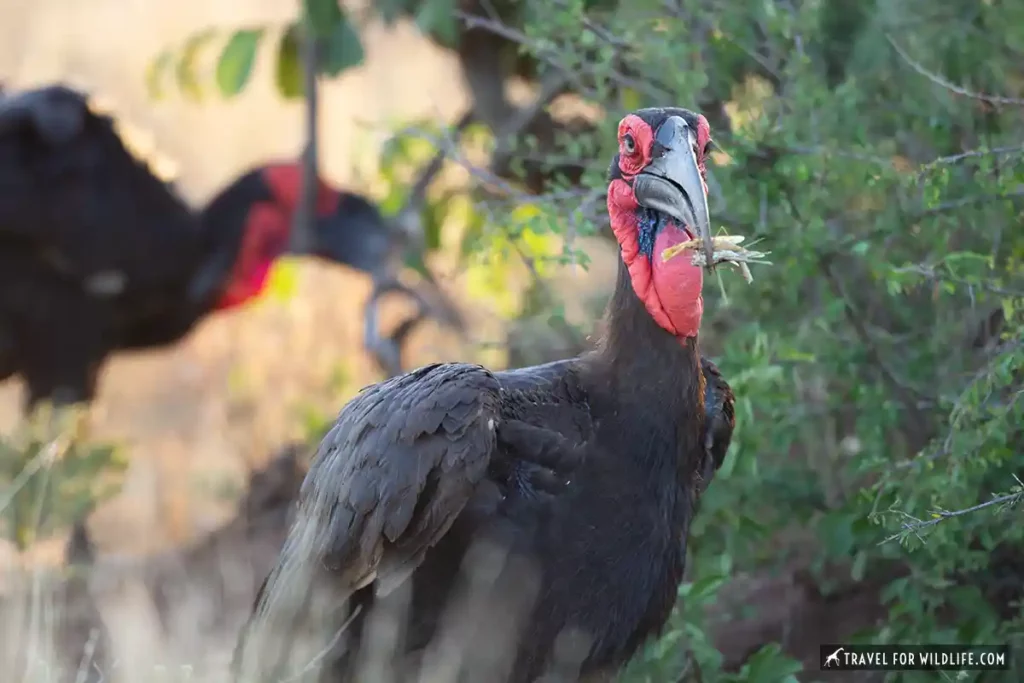
Southern red-billed hornbill (Tockus rofurostris)
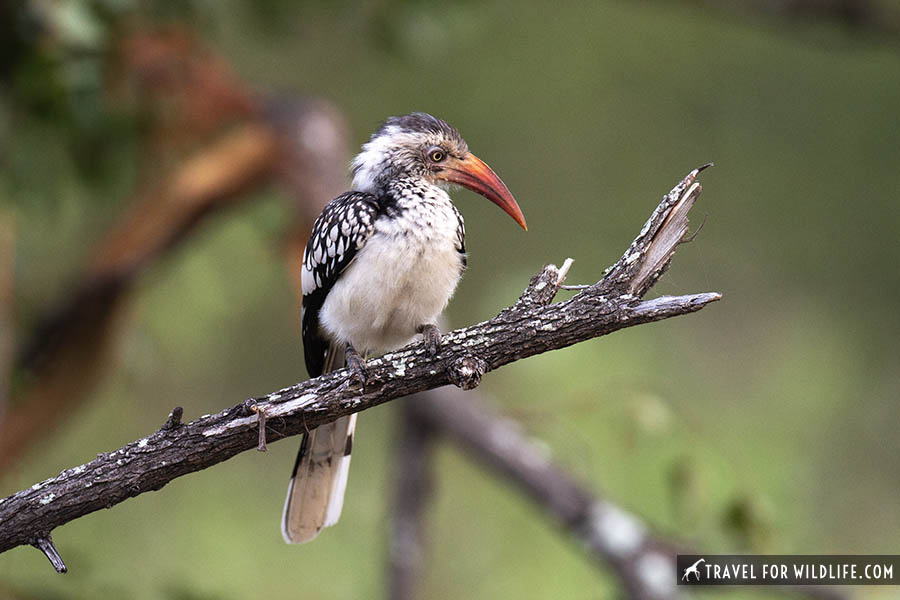
Length: 15.5 – 29 inches, Weight: 4.9 ounces
Conservation status: Least concern (IUCN Red List 2016)
The Southern red-billed hornbill (Tockus rofurostris) is a medium-sized hornbill that can be distinguished by its yellow eyes, red beak, an a black patch in it lower mandible.
Southern red-billed hornbills inhabit the savannah and open woodlands along riverine grasslands. They can also be found in semi-desert like in the Kalahari.
While you can find southern red-billed hornbills in trees, they forage for prey on the ground. Their diet is mainly invertebrates, although occasionally will prey on small rodents, birds nestlings, lizards, and some fruits. They will search for small beetles and fly larvae by digging in soil or in animal dung.
Found normally in pairs or in small groups, they favor Mopane forests, thornveld, savannah and other dry habitats. During the dry season when not breeding, they become somewhat nomadic in most areas and flocks may form, feeding together and gathering at water holes in the savanna where dung piles and food are plentiful, but often returning to roost in their territory.
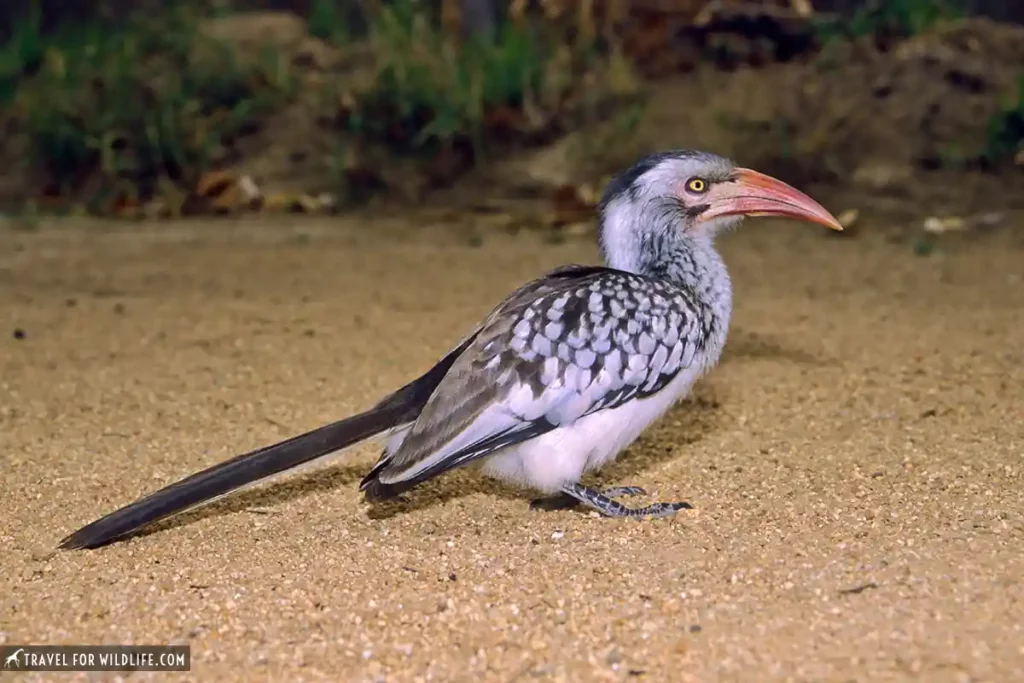
Southern yellow-billed hornbill (Tockus leucomelas)
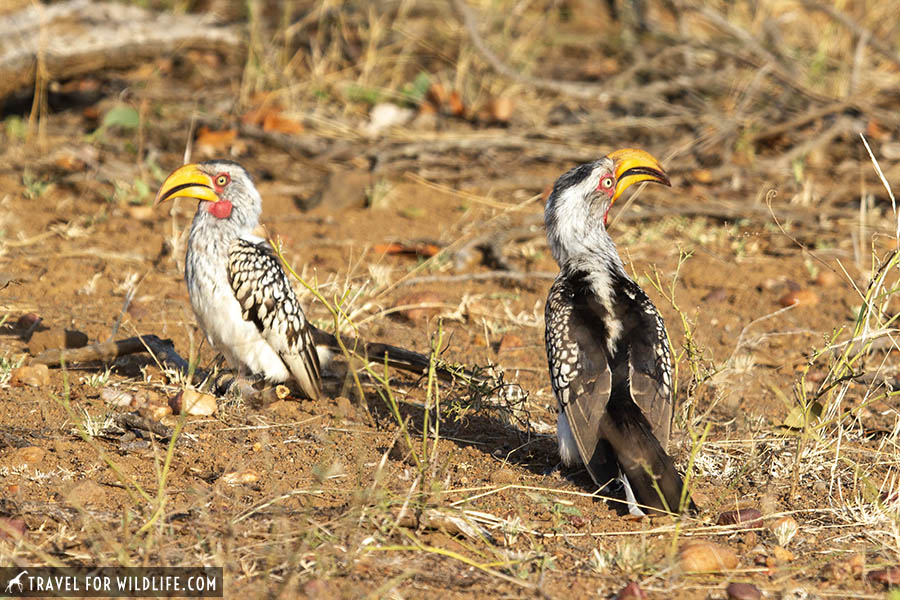
Length: 19 – 23.5 inches, Weight: 4.6 – 8.5 ounces
Conservation status: Least concern (IUCN Red List 2016)
With a range similar to that of the African grey hornbill, the Southern yellow-billed hornbill (Tockus leucomelas) is a very curious bird and entertaining to watch.
Southern yellow-billed hornbills inhabit the savannah and open woodlands, along riverine grasslands. They can also be found in semi-desert like the Kalahari.
They feed on the ground, and search in the leaf litter for small invertebrates. When available, they will eat small rodents, birds eggs, and nestlings. They are territorial, and are found in pairs or in small family flocks. The genus name “Tockus” refers to the distinctive “tock tock tock” call these hornbills make.
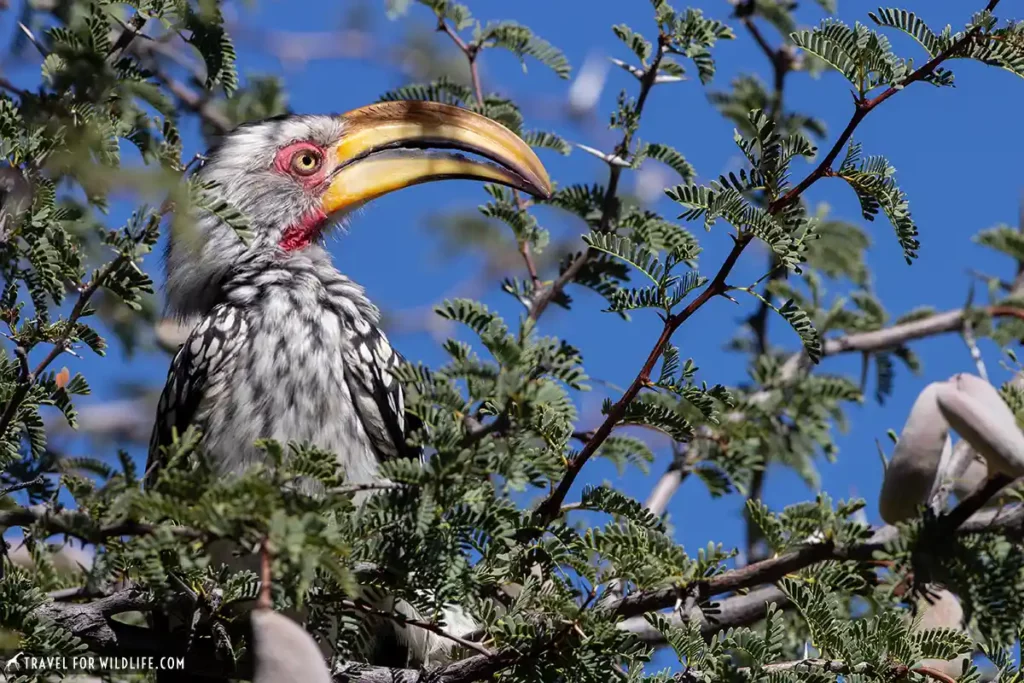
During one of our visits to the Kgalagadi Transfontier National Park, we were staying in a cabin at Urikaruus Wilderness Camp when a tap on the window glass woke us up. There were two southern yellow-billed hornbills ‘knocking’ at our window! We suspected they saw their own reflection in the glass and weren’t amused by it! This is because, to them, they are fighting an intruder when they see their reflection.
Whenever we see these hornbills, we try and follow them for a while as they like to investigate everything and they entertain us for hours.
African grey hornbill (Lophoceros nasutus)
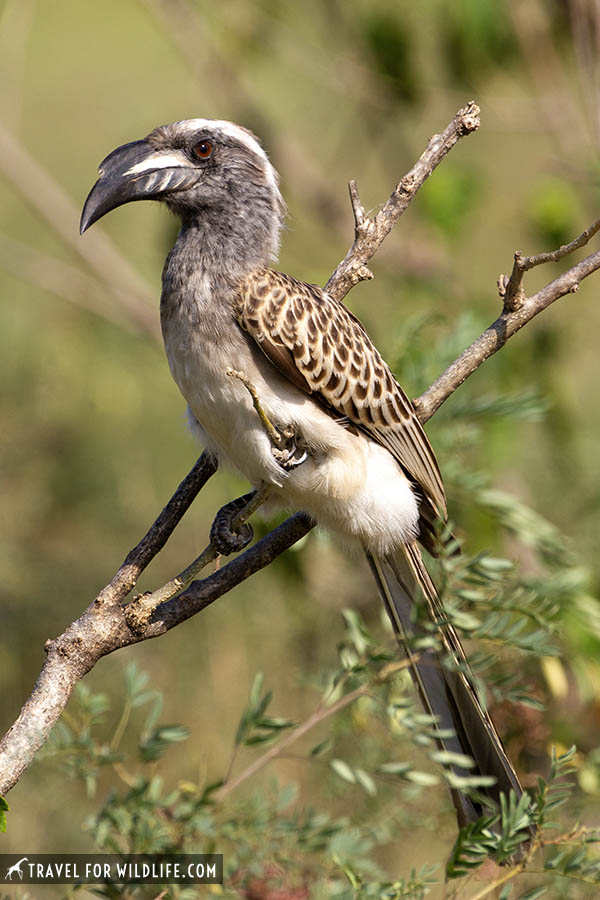
Length: 15.5 – 18.5 inches, Weight: 5.5 ounces
Life expectancy: 20 years
Conservation status: Least concern (IUCN Red List 2016)
This medium-sized hornbill can be distinguished from the other hornbills of South Africa by their large black down-curved bill and conspicuous casque.
African grey hornbills (Lophoceros nasutus) are territorial and can be found in resident pairs during their mating season or in large flocks during non breeding season. They favor wooded habitats and large thickets.
The trumpeter hornbill is omnivorous. Its diet consists of large insects, crabs, eggs, nestlings, reptiles, small birds, and various fruits. They are especially fond of the fruits of the Natal Mahogany tree and figs. They can spend hours foraging in a single tree.
With a range very similar to that of Southern yellow hornbills, the African grey hornbill (Lophoceros nasutus) is distinguishable from other hornbills by the white markings on the lower mandible.
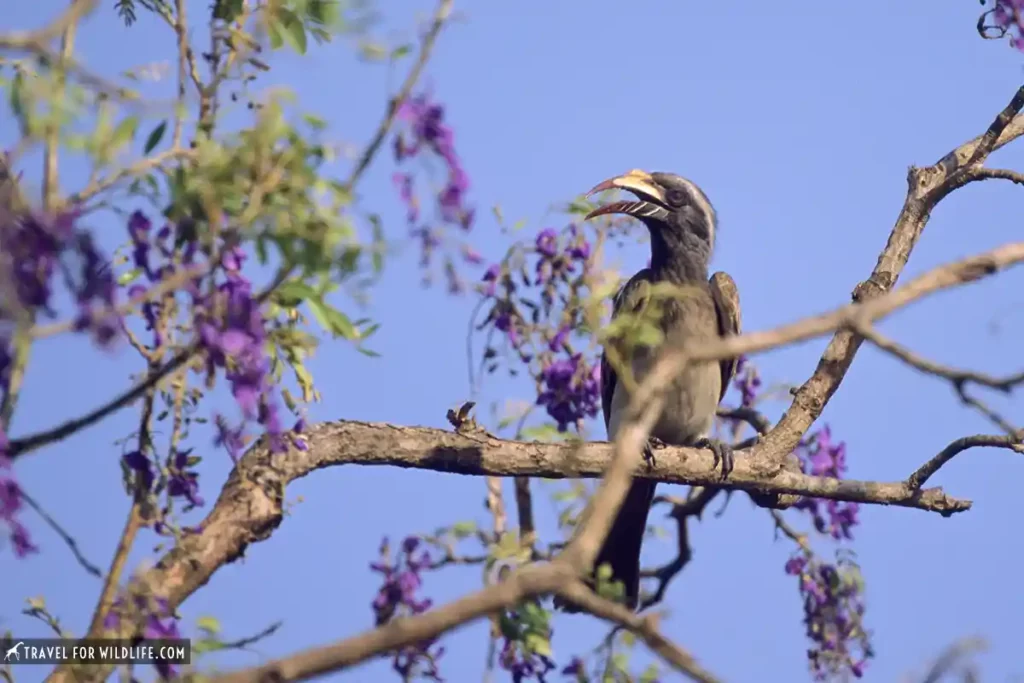
Trumpeter hornbill (Lophoceros alboterminatus)
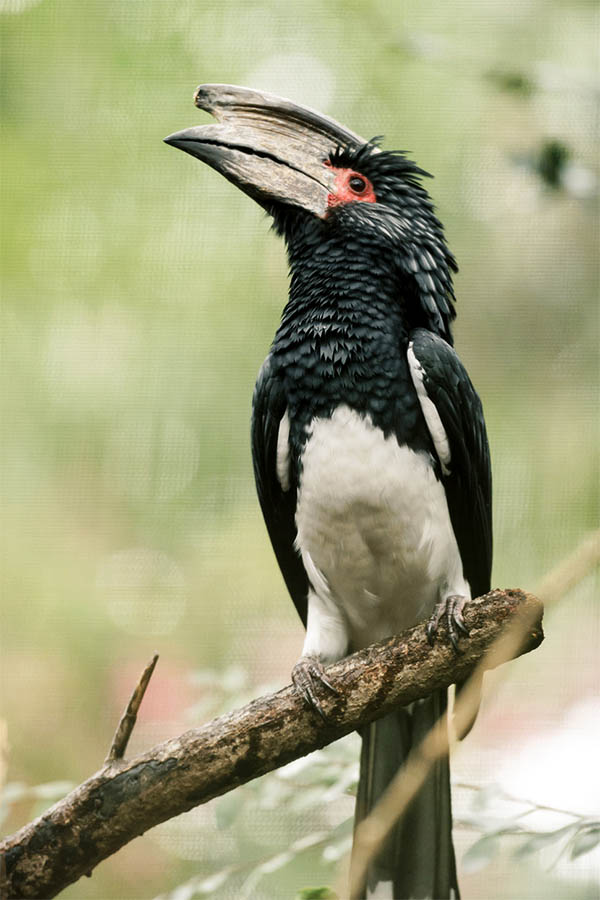
Length: 23 – 25.5 inches, Weight: 0.9 to 2.2 pounds
Conservation status: Least concern (IUCN Red List 2018)
Found in forests, the trumpeter hornbill (Lophoceros alboterminatus) has mostly black plumage with a white belly. It’s the hornbill species in Kruger that we find most challenging to spot.
Their diet consists of fruit (their favorites are figs, berries, and drupes) and enjoy foraging in dense foliage where they hunt for invertebrates and nestlings.
Trumpeter hornbills are often found in pairs (the breeding pair), or in small family groups of 3 to 5 individuals. However, this hornbill species regularly gathers with other trumpeters to form groups of a few dozen. They roost in large dense trees in flocks of up to 200 individuals. At dawn pairs of trumpeters will head out to forage in different directions.
Where to see the hornbills of South Africa
To see hornbills in Africa, your best bet is to head out to northern South Africa. Kruger National Park is the sweet spot, where you can find all the hornbills in South Africa. We particularly like the north of the park, where the camps are quieter. We especially like Punda Maria rest camp, Letaba rest camp, and Tsendze rustic camp.

Cristina Garcia
Zoologist and wildlife photographer. She has worked in the field with jackals, wolves, cheetahs, & leopards. She serves on the Board of Directors of SEE Turtles, a non-profit sea turtle conservation organization.
Read her posts at Travel For Wildlife and see more of her work at Truly Wild, & Our Wild Yard.
